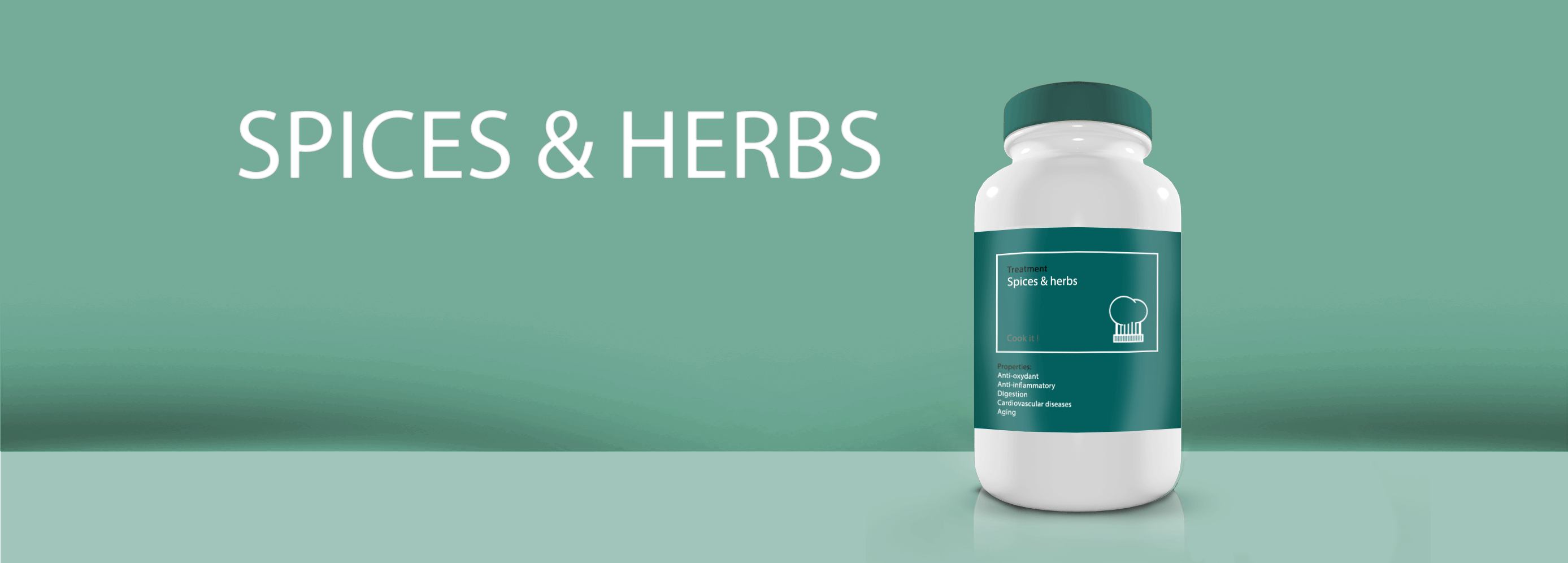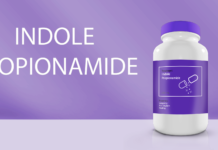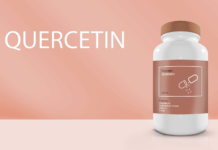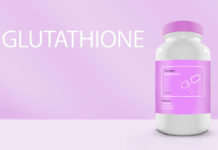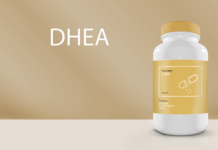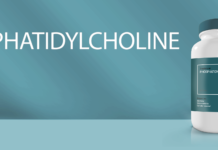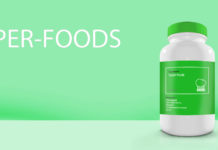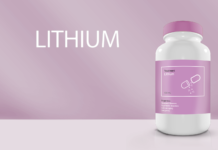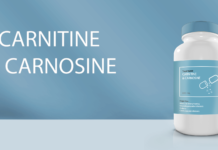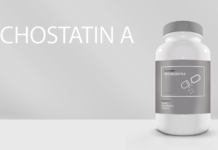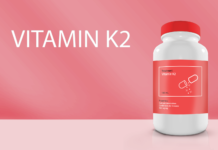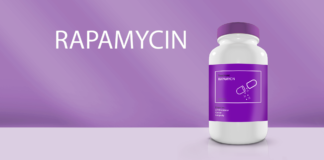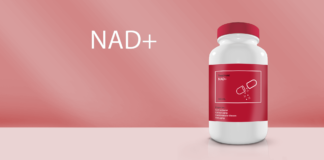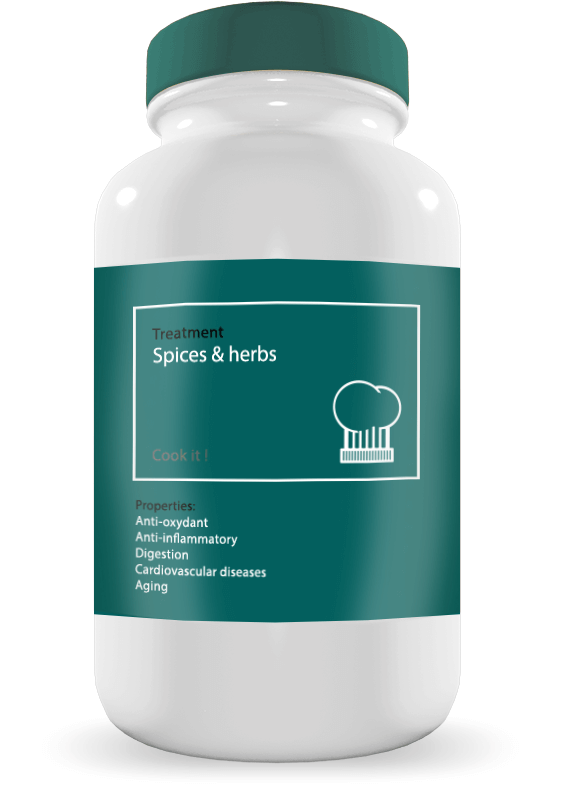
Factsheet
Anti-aging herbs and spices
Just as there are super foods, there are super spices, including cinnamon, cloves, thyme, pepper and of course curcuma, from which curcumin is derived. However, they are not the only ones to add to your meals to help you fight against aging and many are the spices and herbs with anti-aging virtues.
Aromatic herbs
All aromatic herbs have some degree of antioxidant power, protecting us against oxidative stress, a phenomenon that increases with age. Coriander, sage and thyme top the list of herbs richest in antioxidants, particularly phenolic acids, rosmarinic acid and carnosic acid[1, 2, 3]. All three protect against the appearance of cardiovascular diseases by reducing the oxidation of circulating lipids they cause[4, 5].
Coriander also contains carotenoids (which are converted into vitamin A in our body in the presence of lipids), a relatively rare but important antioxidant[1]. Coriander, always, participates in the decrease of glycemia and supports the entry of sugar in the cells, which makes it a good adjuvant for anti-diabetic drugs[6]. It is also anti-bacterial and contains a large amount of vitamin K.
Thyme, on the other hand, has an active ingredient, thymol, which enhances the effect of its antioxidants by adding anti-aggregating properties (reduces the formation of blood clots) and vasodilators (increases nitric oxide synthesis)[7, 8]. It is also a good anti-inflammatory and healing agent, used since the Antiquity in the treatment of lung diseases, such as bronchitis, and compresses to help wound healing[9]. Like coriander, it is very rich in vitamin K, but also in iron.
Sage takes the cake for antioxidant herbs, with a notable hypotriglyceridemic and hypoglycemic effect[3]. In parallel, a study showed that, in an Alzheimer cohort, sage supplementation improved cognitive function and decreased patient agitation[10]. Finally, it seems to play a role in relieving hot flashes in menopausal women[11].
Other aromatic herbs have an interesting antioxidant concentration. Basil and mint share the same capacities as coriander, with a cardioprotective and vasoprotective effect[12]. Basil is also hypoglycemic and studies have established its role in protecting against cancer[13, 14].
Mint, on the other hand, increases iron absorption[15].
Oregano is an interesting hypoglycemic and anti-aggregant to add to our diet, although to be taken with great care in women, because it is an abortifacient in high doses[16, 17].
Finally, rosemary has long been used to relieve rheumatism, stress and fatigue when applied in poultices[18]. It is a powerful anti-inflammatory that stimulates liver function and appears to have a protective effect against cancer[19].
Roots and spices
We will not talk about curcuma or turmeric, which has its own factsheet.
Ginseng has long been recognized for its benefits, especially in Asian communities. In China, it is considered a “divine herb” because of its various applications. It has been used for centuries as a tonic in the elderly, to keep them alert and healthy, as well as an aphrodisiac. More recently, studies have shown its involvement in maintaining physical performance (which is similar to the idea of tonic), cardiovascular health, metabolic diseases such as diabetes and cancer[20]. This root alone deserves a full article! It appears to be involved in many age-related processes; for example, it slows hearing loss, the onset of neurological diseases and loss of insulin sensitivity, protects our heart and overall increases life span[21, 22, 23, 24, 25]. Ginseng exists in many forms, the most effective and antioxidant appearing to be red ginseng.
Paprika is one of the spices with many benefits. It is anti-inflammatory and helps relieve arthritic pain, boosts our immune system and contributes to the good health of our cardiovascular system, thanks to its vasodilating properties[26]. It is also very rich in vitamins E, K and B2. Saffron has a similar action, with even greater antioxidant capacities. Cardamom is one of the oldest spices used, just like ginseng, and has about the same properties, although less powerful. It is particularly stimulating, contributes to good intellectual health and fights against cognitive decline. Incidentally, it provides digestive well-being and limits acid reflux[27].
Cinnamon is one of the super spices and it bears its name well. Extremely rich in antioxidants, it modulates oxidative stress, reduces inflammatory and allergic reactions and reduces circulating lipids, thus protecting our cardiovascular system[28, 29, 30]. It also seems to have a role as an adjuvant to anti-diabetic treatments[30]. Cloves belong to this same family of super spices, just like cayenne pepper. Although relatively little studied in the scientific literature, cloves are the spice richest in antioxidants, suggesting a role in controlling oxidative stress. Cayenne pepper is also well known in practice, but little studied. It is an anti-inflammatory, a stimulant, and an anti-stress, widely used in the form of essential oil to treat muscle and joint pain, digestive problems and stimulate blood circulation[31]. All its actions contribute to maintaining our body in good health and to limiting age-related pathologies. Finally, Cayenne pepper, and spices rich in capsaicin (which gives the pepper its spicy taste), are known for their action on arthritic, muscular and neuropathic pains[32].
Spices and herbs, many of which have been used for millennia, have a variety of benefits, but all seem to either relieve the effect of age, or prevent certain diseases associated with aging and slow it down slightly. Don’t wait, don’t hesitate to eat a little spicier!
- Number of publications: Approximately 5000
- Available molecule: over-the-counter
- Route: oral
- Dosage: depends on the spices. For aromatic herbs, it is recommended either to add them directly into the diet, up to 200 to 500 mg per day, or to make herbal teas (5-6 leaves per 100 ml of water). They can also be used as essential oils. For spices, add 1 to 5 teaspoons in your preparations. You can also use them in the form of essential oils, including cayenne pepper, which is much more effective in topical application.
In reasonable quantity, spices and aromatic herbs have very few side effects, except the obvious stomachache for sensitive people.
However, sage should be taken in small doses as it can cause seizures in epileptics. It is also a potential abortifacient, just like rosemary. Rosemary exists in several forms, rosemary with camphor being the most widely used for topical application and rosemary with verbérone, less frequent, being to be applied sparingly because it is neurotoxic and abortifacient in high doses. Mint can cause some gastroesophageal reflux.
Be careful not to dry the coriander, sage and mint leaves, they lose a lot of their benefits. You can keep them in the refrigerator or even freeze them. Spices can be kept in airtight cans for up to 6 months after opening. Afterwards, their contents begin to alterate, as much as their taste.
[1] Wangensteen H, Samuelsen AB, Malterud KE. Antioxidant activity in extracts from coriander. Food Chemistry 2004;88:293-7
[2] Masuda T, Inaba Y, Maekawa T et al. Recovery mechanism of the antioxidant activity from carnosic acid quinone, an oxidized sage and rosemary antioxidant. J Agric Food Chem. 2002;50:5863-5869
[3] Ninfali P, Mea G, Giorgini S et al. Antioxidant capacity of vegetables, spices and dressings relevant to nutrition. Br J Nutr. 2005;93:257-266
[4] Chithra V, Leelamma S. Hypolipidemic effect of coriander seeds (Coriandrum sativum): mechanism of action. Plant Foods HumNutr 1997;51(2):167-72
[5] Ninomiya K, Matsuda H, Shimoda H et al. Carnosic acid, a new class of lipid absorption inhibitor from sage. Bioorg Med Chem Lett. 2004;14:1943-1946
[6] Gray AM, Flatt PR. Insulin-releasing and insulin-like activity of the traditional anti-diabetic plant Coriandrum sativum (coriander). Br J Nutr 1999;81(3):203-9.
[7] Yamamoto J, Yamada K, Naemura A et al. Testing various herbs for antithrombotic effect. Nutrition. 2005;21:580-587
[8] Grande S, Bogani P, de Saizieu A et al. Vasomodulating potential of mediterranean wild plant extracts. J Agric Food Chem. 2004;52:5021-5026
[9] Ernst E, Marz R, Sieder C. A controlled multi-centre study of herbal versus synthetic secretolytic drugs for acute bronchitis. Phytomedicine 1997;4:287-293.
[10] Akhondzadeh S, Noroozian M, Mohammadi M et al. Salvia officinalis extract in the treatment of patients with mild to moderate Alzheimer’s disease: a double blind, randomized and placebo-controlled trial. J Clin Pharm Ther. 2003;28:53-59
[11] Bommer S, Klein P, Suter A.First time proof of sage’s tolerability and efficacy in menopausal women with hot flushes. AdvTher. 2011;28(6):490-500
[12] Geetha RK, Vasudevan DM. Inhibition of lipid peroxidation by botanical extracts of Ocimum sanctum: in vivo and in vitro studies. Life Sci. 2004;76:21-28
[13] Vats V, Grover JK, Rathi SS. Evaluation of anti-hyperglycemic and hypoglycemic effect of Trigonella foenum-graecum Linn, Ocimum sanctum Linn and Pterocarpus marsupium Linn in normal and alloxanized diabetic rats. J Ethnopharmacol. 2002;79:95-100.
[14] Dasgupta T, Rao AR, Yadava PK. Chemomodulatory efficacy of basil leaf (Ocimum basilicum) on drug metabolizing and antioxidant enzymes, and on carcinogen-induced skin and forestomach papillomagenesis. Phytomedicine. 2004;11(2-3):139-51
[15] Hurrell RF, Reddy M, Cook JD. Inhibition of non-haem iron absorption in man by polyphenolic-containing beverages. Br J Nutr. 1999;81:289-295
[16] Lemhadri, A et coll. Anti-hyperglycaemic activity of the aqueous extract of Origanum vulgare growing wild in Tafilalet region. J Ethnopharmacol. 2004;92(2-3):251-256.
[17] Goun, E. et coll. Antithrombin activity of some constituents from Origanum vulgare. Fitoterapia 2002;73(7-8):692-694.
[18] Klancnik A, Guzej B, Kolar MH. In vitro antimicrobial and antioxidant activity of commercial rosemary extract formulations. J Food Prot. 2009;72(8):1744-52).
[19] Petiwala SM, Johnson JJ. Diterpenes from rosemary (Rosmarinus officinalis): Defining their potential for anti-cancer activity. Cancer Lett. 2015;367(2):93-102
[20] Shergis JL, Zhang AL, Zhou W, Xue CC.Panax ginseng in randomised controlled trials: a systematic review. Phytother Res. 2013;27(7):949-65
[21] Tian C, Kim YJ, Lim HJ, Kim YS, Park HY, Choung YH. Red ginseng delays age-related hearing and vestibular dysfunction in C57BL/6 mice. Exp Gerontol.2014;57:224-32
[22] Ong WY, Farooqui T, Koh HL, Farooqui AA, Ling EA.Protective effects of ginseng on neurological disorders. Front Aging Neurosci.2015;7:129
[23] Seo E, Kim S, Lee SJ, Oh BC, Jun HS. Ginseng> berry extract supplementation improves age-related decline of insulin signaling in mice. Nutrients. 2015;7(4):3038-53
[24] Luo P, Dong G, Liu L, Zhou H. The Long-Term Consumption of Ginseng Extract Reduces the Susceptibility of Intermediate-Aged Hearts to Acute Ischemia Reperfusion Injury. PLoS One. 2015;10(12):e0144733
[25] Kim MS. Korean Red Ginseng Tonic Extends Lifespan in D. melanogaster. Biomolecules & Therapeutics. 2013;21(3):241-245
[26] Otunola GA, Oloyede OB, Oladiji AT, Afolayan AJ. Selected spices and their combination modulate hypercholesterolemia-induced oxidative stress in experimental rats. Biological Research. 2014;47(1):5
[27] Gilani, Q. Jabeen, A. Khan, A. Shah. Gut modulatory, blood pressure lowering, diuretic and sedative activities of cardamom, J Ethnopharmacol. 2008;115(3):463-72
[28] Prior RL, Gu L. Occurrence and biological significance of proanthocyanidins in the American diet. Phytochemistry, 2005;66(18):2264-80
[29] Prasad NS, Raghavendra R, et al. Spice phenolics inhibit human PMNL 5-lipoxygenase. Prostaglandins Leukot Essent Fatty Acids, 2004;70(6):521-8
[30] Khan A, Safdar M, et al. Cinnamon improves glucose and lipids of people with type 2 diabetes. Diabetes Care, 2003;26(12):3215-8
[31] Tapsell LC, Hemphill I, et al. Health benefits of herbs and spices: the past, the present, the future. Med J Aust. 2006;185(4 Suppl):S4-24.
[32] Mason L, Moore RA, et al. Systematic review of topical capsaicin for the treatment of chronic pain. BMJ. 2004;328(7446):991
Dr. Marion Tible

Author/Reviewer
Auteure/Relectrice
Marion Tible has a PhD in cellular biology and physiopathology. Formerly a researcher in thematics varying from cardiology to neurodegenerative diseases, she is now part of Long Long Life team and is involved in scientific writing and anti-aging research.
More about the Long Long Life team
Marion Tible est docteur en biologie cellulaire et physiopathologie. Ancienne chercheuse dans des thématiques oscillant de la cardiologie aux maladies neurodégénératives, elle est aujourd’hui impliquée au sein de Long Long Life pour la rédaction scientifique et la recherche contre le vieillissement.
En savoir plus sur l’équipe de Long Long Life


